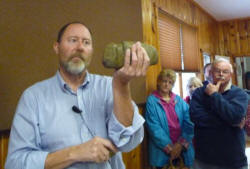 Wiant inspected and commented on various artifacts that local
residents brought along with them. These items included arrowheads
of all sorts (spear heads, knives, drills and arrow tips), axes,
mallets, work stones and more. Wiant usually was able to give
approximate dates, which went back several hundreds of years to when
there were several fairly large Indian communities of 100-200
members in the Logan County area around Salt Creek and around Lake
Fork, which was quite a large lake in those days. Wiant inspected and commented on various artifacts that local
residents brought along with them. These items included arrowheads
of all sorts (spear heads, knives, drills and arrow tips), axes,
mallets, work stones and more. Wiant usually was able to give
approximate dates, which went back several hundreds of years to when
there were several fairly large Indian communities of 100-200
members in the Logan County area around Salt Creek and around Lake
Fork, which was quite a large lake in those days.The director
explained that most small arrowheads were pared down from larger
ones due to re-sharpening their tips caused by breakage when the
arrowhead-tipped spear slammed into its intended game animal and hit
a bone. The smaller ones, then, were used for tips of smaller spears
and/or finally on arrows.
Many have incorrectly believed that the Indians put some twist
into their arrowheads (for better dynamics when in flight) when
shaping, but this is not held to be true any longer. The "twist"
comes from the simple fact that the arrowhead has been re-sharpened
several times on one side and then the other to get the tip back to
its sharpened state. The feathers on the arrow provided all the
aero-dynamics needed for a true flight of the arrow.
And, the Indians knew how to serrate their arrowheads to be used
for sawing or knife cutting.
Wiant says all
of this "connecting of the past" work changed significantly
throughout the world of archaeology when, in 1950, radioactive
dating was discovered. This process is so accurate that they can get
results, they believe, within 60-70 years

Wiant spoke of the upward grade along Interstate 55 from Lawndale
to Bloomington where the last ice age stopped on its southward
movement through Illinois. Scientists ascertain this by dating rocks
that were pushed along and over by these glacial occurrences that
swept through Illinois, going as far south as the Carbondale area,
in the first glacial age.

He said that prior to 20,000 years ago there were no humans in
the Americas. Then, he said, peoples from Asia were probably the
first inhabitants, trekking across the Alaskan connection down
through Canada into the West Coast regions and on down into South
America, all the way to Chile, where excavated artifacts show these
people came from Asia, not Europe. This occurred around
10,000-15,000 years ago when these Asian Indians hunted bison.
Several skeletal bison have been found with arrowheads lodged in
their bones. He spoke of these natives having domesticated dogs
around 8,500 years ago.
The director spoke of the very important discovery by these
Indians of cultivation of plants, which became crops good for
sustenance about 1,000 years ago. He remarked that this is the "big
reason we are all here." Along with this was the discovery of
containers to cook, serve and store these plant foods, primarily
with the invention of ceramic (clay) pots. Previously, weavers made
baskets that could even hold water, but cooking containers created
an entirely different world.
[to top of second column] |

Wiant spoke of the bow and arrow invention that revolutionized
Indian hunting and warfare. This invention "went from the East Coast
to the West Coast very quickly," he said.
He said that maize was invented about 500 A.D., but it led to
health problems that caused tremendous diseases and the wiping out
of entire tribes over the years.
Wiant talked more about the Illinois Indians, saying that it was
primarily the Kickapoo Indians who roamed this state from 1700 to
1800. The Potawatomies and Iroquois were also in our area, the
latter laying waste to the Starved Rock region in the early 19th
century. He said that the Iroquois took about 600 native prisoners
back to the New York State area.
The Dickson Mounds director spoke of Gen. Benjamin Harrison,
later a U.S. president, making a very important treaty with the
Indians that freed all of the Illinois region to white settlers.
When Harrison signed the 1809 Treaty of Fort Wayne with several
native tribes, the United States acquired 3 million acres of land,
which included the Indiana and Illinois territories, with a single
document.

Wiant told of an important discovery of a Native American
community near Broadwell when I-55 was being built in the 1970s.
A Mr. C.C. Ewing of Lawndale described what the local central
Illinois Native Americans looked like in the early 1800s.
Wiant said that by 1837, the Indians were pretty much gone from
Illinois, with the Black Hawk War of 1832 hastening this process. He
spoke of the "Trail of Death" of the Potawatomies from South Bend,
Ind., through central Illinois and southern Logan County on to
Kansas in 1838.
[By PHIL BERTONI]

 |